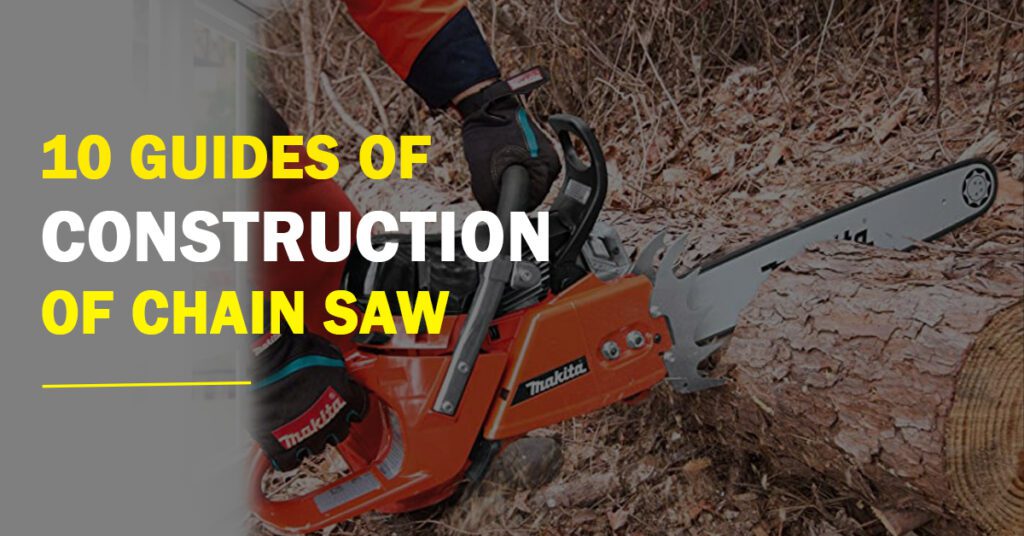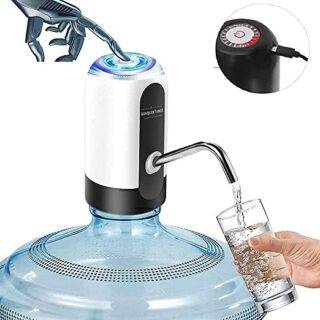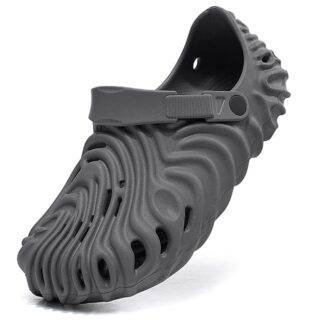
Table of Contents
ToggleIntroduction

Chainsaws are typically constructed using several key components. These include the engine, guide bar, cutting chain, and various safety features.
The engine of a chainsaw is usually a two-stroke gasoline-powered engine, although electric and battery-powered options are also available. The engine generates the power needed to spin the cutting chain, which is responsible for actually cutting through wood or other materials.
The guide bar is a long, flat metal bar that provides support for the cutting chain. It typically extends out from the front of the chainsaw and is fitted with a sprocket at its base that rotates the chain. The guide bar also contains small oil holes that lubricate the chain as it moves.
The cutting chain is a loop of metal teeth that are sharpened to slice through wood or other materials. The chain is wrapped around the guide bar and is driven by the sprocket at its base. Chainsaws typically have various chain sizes and tooth configurations available, depending on the type of cutting that needs to be done.
To ensure user safety, chainsaws are equipped with several safety features, including chain brakes, throttle locks, and anti-vibration systems. The chain brake is a mechanism that stops the chain from moving if the chainsaw encounters kickback, sudden resistance, or other hazardous conditions. The throttle lock is a switch that prevents accidental activation of the throttle trigger. Anti-vibration systems help to reduce the amount of vibration that the user feels while operating the chainsaw, which can reduce fatigue and the risk of injury.
Chainsaws are typically constructed using several key components. These include the engine, guide bar, cutting chain, and various safety features.
The engine of a chainsaw is usually a two-stroke gasoline-powered engine, although electric and battery-powered options are also available. The engine generates the power needed to spin the cutting chain, which is responsible for actually cutting through wood or other materials.
The guide bar is a long, flat metal bar that provides support for the cutting chain. It typically extends out from the front of the chainsaw and is fitted with a sprocket at its base that rotates the chain. The guide bar also contains small oil holes that lubricate the chain as it moves.
The cutting chain is a loop of metal teeth that are sharpened to slice through wood or other materials. The chain is wrapped around the guide bar and is driven by the sprocket at its base. Chainsaws typically have various chain sizes and tooth configurations available, depending on the type of cutting that needs to be done.
To ensure user safety, chainsaws are equipped with several safety features, including chain brakes, throttle locks, and anti-vibration systems. The chain brake is a mechanism that stops the chain from moving if the chainsaw encounters kickback, sudden resistance, or other hazardous conditions. The throttle lock is a switch that prevents accidental activation of the throttle trigger. Anti-vibration systems help to reduce the amount of vibration that the user feels while operating the chainsaw, which can reduce fatigue and the risk of injury.
The engine in chain saws
The engine is a crucial component of a chainsaw, as it provides the power needed to drive the cutting chain. Most chainsaws use a two-stroke gasoline engine, which is compact and lightweight but can generate a lot of power. Some chainsaws may also use electric or battery-powered engines, which are quieter and produce fewer emissions but may have less power.
The engine in a chainsaw typically consists of a cylinder, piston, and crankshaft. When fuel and air are mixed and ignited in the cylinder, the resulting explosion drives the piston down, which in turn rotates the crankshaft. The crankshaft is connected to a clutch, which engages with the guide bar and cutting chain to drive it forward.
The power output of a chainsaw engine is typically measured in horsepower or watts. The amount of power needed depends on the size and type of cutting that needs to be done. Larger chainsaws with longer guide bars and cutting chains typically require more power to operate effectively.
To keep the engine running smoothly, chainsaws require regular maintenance, including oil changes, air filter replacements, and spark plug replacements. Proper maintenance can help extend the life of the engine and ensure that the chainsaw operates safely and effectively.
Machine in chain saws
Chainsaws are a type of machine that uses an engine to power a cutting chain that is used to cut through wood or other materials. The machine is made up of several key components, including the engine, guide bar, cutting chain, and safety features.
The engine is the heart of the machine, providing the power needed to spin the cutting chain. Chainsaws typically use a two-stroke gasoline engine, although electric and battery-powered options are also available. The engine is connected to the guide bar and cutting chain via a clutch mechanism, which engages and disengages the chain as needed.
The guide bar is a long, flat metal bar that extends out from the front of the chainsaw and provides support for the cutting chain. It is typically fitted with a sprocket at its base that rotates the chain. The guide bar also contains small oil holes that lubricate the chain as it moves.
The cutting chain is a loop of metal teeth that are sharpened to cut through wood or other materials. The chain is wrapped around the guide bar and is driven by the sprocket at its base. Chainsaws typically have various chain sizes and tooth configurations available, depending on the type of cutting that needs to be done.
To ensure user safety, chainsaws are equipped with several safety features, including chain brakes, throttle locks, and anti-vibration systems. The chain brake is a mechanism that stops the chain from moving if the chainsaw encounters kickback, sudden resistance, or other hazardous conditions. The throttle lock is a switch that prevents accidental activation of the throttle trigger. Anti-vibration systems help to reduce the amount of vibration that the user feels while operating the chainsaw, which can reduce fatigue and the risk of injury.
Overall, the machine in a chainsaw is designed to be powerful, efficient, and safe to use, making it a valuable tool for many different types of cutting and trimming tasks.
Chain in chain saws
The chain in a chainsaw is a critical component that is responsible for cutting through wood or other materials. The chain is made up of a series of sharp metal teeth that rotate around a guide bar, which is driven by the chainsaw’s engine. The chain is designed to be durable and withstand the stress of cutting through dense materials.
Chainsaw chains come in a variety of sizes and types, depending on the specific cutting task. The size of the chain is determined by the length of the guide bar, which can range from just a few inches to several feet long. Chains with longer guide bars tend to be more powerful and are used for larger cutting jobs, while smaller chains are used for lighter tasks.
The teeth on the chain are sharpened to a specific angle and are designed to cut through wood fibers cleanly and efficiently. Chainsaw chains typically have a “pitch,” which is the distance between the centers of any two consecutive chain rivets, as well as a “gauge,” which is the thickness of the drive link that fits into the guide bar.
To keep the chain in good working condition, it is important to keep it properly lubricated with oil. Most chainsaws have an automatic oiler that releases oil onto the chain as it rotates, helping to reduce friction and prevent the chain from overheating or becoming damaged.
Regular maintenance of the chain, including sharpening the teeth and checking for damage or wear, can help extend its lifespan and ensure that the chainsaw operates safely and effectively. It is also important to use the correct chain for the specific cutting task and to follow all safety guidelines when using a chainsaw.
What Happens Inside A Chainsaw?
Inside a chainsaw, several components work together to power the cutting chain and allow it to cut through wood or other materials. These components include the engine, guide bar, cutting chain, and various safety features.
The engine is typically a two-stroke gasoline engine that provides the power needed to drive the cutting chain. When fuel and air are mixed and ignited in the engine’s cylinder, the resulting explosion drives the piston down, which in turn rotates the crankshaft. The crankshaft is connected to a clutch, which engages with the guide bar and cutting chain to drive it forward.
The guide bar is a long, flat metal bar that extends out from the front of the chainsaw and provides support for the cutting chain. It is typically fitted with a sprocket at its base that rotates the chain. The guide bar also contains small oil holes that lubricate the chain as it moves.
The cutting chain is a loop of metal teeth that are sharpened to cut through wood or other materials. The chain is wrapped around the guide bar and is driven by the sprocket at its base. Chainsaws typically have various chain sizes and tooth configurations available, depending on the type of cutting that needs to be done.
To ensure user safety, chainsaws are equipped with several safety features, including chain brakes, throttle locks, and anti-vibration systems. The chain brake is a mechanism that stops the chain from moving if the chainsaw encounters kickback, sudden resistance, or other hazardous conditions. The throttle lock is a switch that prevents accidental activation of the throttle trigger. Anti-vibration systems help to reduce the amount of vibration that the user feels while operating the chainsaw, which can reduce fatigue and the risk of injury.
Overall, a chainsaw is a complex piece of machinery that is designed to be powerful, efficient, and safe to use. By understanding how the various components work together, users can ensure that their chainsaw is operating properly and safely, allowing them to complete their cutting tasks quickly and effectively.
Centrifugal Clutch In Chainsaws
A centrifugal clutch is a key component of a chainsaw’s power transmission system. It is responsible for engaging and disengaging the cutting chain from the engine, which allows the user to control the speed and power of the chainsaw.
The centrifugal clutch is located on the end of the crankshaft, and it is connected to the guide bar and cutting chain. When the engine is running, the clutch spins along with the crankshaft, which causes a set of weighted arms inside the clutch to extend outwards due to centrifugal force. As the arms extend, they engage with the clutch drum, which in turn drives the guide bar and cutting chain.
When the engine speed drops, the centrifugal force on the weighted arms decreases, and they retract back into the clutch housing. This causes the clutch drum to disengage from the cutting chain, which slows down or stops the chain’s movement.
The centrifugal clutch is designed to be sensitive to changes in engine speed, which allows it to respond quickly to changes in cutting conditions. If the chainsaw encounters a sudden increase in resistance, such as when it encounters a knot in the wood, the engine speed will drop, causing the centrifugal clutch to disengage and stop the chain from rotating. This is an important safety feature that helps to prevent kickbacks and other dangerous situations.
Overall, the centrifugal clutch is a critical component of a chainsaw’s power transmission system, and it helps to ensure that the chainsaw operates safely and effectively. By understanding how it works, users can make informed decisions about how to operate their chainsaw and maintain its performance over time.
Guide bar in chainsaws
The guide bar, also known as the chainsaw bar, is a long, flat metal component that extends out from the front of the chainsaw and provides support for the cutting chain. It is an essential component of the chainsaw, and its length can vary depending on the type of cutting job that needs to be done.
The guide bar is typically made of a hard-wearing metal, such as steel or titanium, and it is designed to withstand the stress and heat generated by the cutting chain. The guide bar has several important features, including a groove along the top that guides the cutting chain, and a sprocket at its base that drives the chain.
The groove on the top of the guide bar is a crucial part of the cutting system. It is designed to hold the cutting chain in place and guide it through the wood or other material being cut. The size and shape of the groove can vary depending on the type of chain being used and the size of the guide bar.
The sprocket at the base of the guide bar is another important component. It is typically made of metal and is designed to engage with the chain drive links, which rotate the cutting chain. The sprocket is also responsible for lubricating the chain as it rotates, which helps to reduce friction and prevent overheating.
Guide bars can come in various sizes, ranging from just a few inches to several feet in length. Longer guide bars tend to be more powerful and are used for larger cutting jobs, while shorter guide bars are used for lighter tasks. The size of the guide bar is typically determined by the engine size of the chainsaw.
Regular maintenance of the guide bar is important to ensure that it operates safely and effectively. This includes checking for wear or damage, cleaning the groove and sprocket regularly, and ensuring that the bar is properly lubricated with oil. By properly maintaining the guide bar, users can ensure that their chainsaw operates at peak performance and remains safe to use.
what is special about chainsaw oil
Chainsaw oil, also known as bar and chain oil, is a specialized lubricant designed for use in chainsaws. It is formulated to provide specific properties that make it suitable for the demanding requirements of chainsaw operation. Here are some key features that make chainsaw oil special:
- Viscosity: Chainsaw oil has a specific viscosity range, typically higher than that of motor oil. Its viscosity allows it to cling to the chainsaw’s bar and chain, providing a continuous lubricating film even at high temperatures and under heavy loads.
- Adhesion: Chainsaw oil is designed to adhere to metal surfaces, particularly the guide bar and chain. It forms a protective layer that reduces friction and wear, preventing damage to the chain and bar while facilitating smooth cutting performance.
- Anti-wear properties: Chainsaw oil contains additives that provide excellent anti-wear properties. These additives form a protective film on metal surfaces, reducing friction and preventing metal-to-metal contact, which can lead to premature wear and damage.
- Tackiness: Chainsaw oil is formulated to have a high tackiness or stickiness. This allows it to adhere to the chain and bar even during high-speed operation, reducing sling-off and ensuring proper lubrication throughout the cutting process.
- Heat resistance: Chainsaw oil is designed to withstand high operating temperatures generated during prolonged cutting. It has good thermal stability, which helps prevent the oil from breaking down and losing its lubricating properties under extreme heat.
- Environmental considerations: Many chainsaw oils are biodegradable or have low environmental impact to minimize harm to the ecosystem in case of leaks or spills during chainsaw operation.
Brakes of chain saws
Chainsaws are powerful and potentially dangerous tools, so it’s important to have safety features in place to prevent accidents. One of the most important safety features of a chainsaw is the chain brake.
The chain brake is designed to stop the cutting chain from rotating in the event of a kickback or other sudden movement of the chainsaw. It is typically operated by a lever located near the top handle of the chainsaw, and it can be engaged manually or automatically.
When the chain brake is engaged, a metal band clamps down on the clutch drum, which stops the rotation of the cutting chain. This helps to prevent injuries and damage to the chainsaw itself. In some models, the chain brake can also be used to stop the engine from running, which provides an additional level of safety.
The chain brake can be engaged manually by pushing a lever forward with the left hand while maintaining a firm grip on the chainsaw with the right hand. Some models also have an automatic chain brake, which engages if the chainsaw experiences a sudden upward movement, such as during a kickback.
It’s important to regularly check the function of the chain brake and ensure that it is working properly before each use. If the chain brake is not functioning correctly, it can be a serious safety hazard.
Overall, the chain brake is an important safety feature in chainsaws, and it helps to prevent accidents and injuries when using this powerful tool. By understanding how it works and regularly maintaining it, users can help to ensure that their chainsaw operates safely and effectively.
Which oil should be used for oiling chainsaws?
The lubrication of a chainsaw is important for its proper functioning and longevity, and the right type of oil should be used for this purpose. Chainsaws typically require two types of oil: bar and chain oil and two-stroke engine oil.
Bar and chain oil is a specialized oil that is designed specifically for use in chainsaws. It is a high-viscosity oil that is specifically formulated to withstand the high-speed rotation of the cutting chain, which can generate a significant amount of heat and friction. Bar and chain oil is designed to cling to the guide bar and lubricate the cutting chain as it rotates, reducing friction and preventing wear and tear.
Two-stroke engine oil is also required for chainsaws that use a two-stroke engine. This type of oil is mixed with the gasoline to lubricate the engine’s moving parts. Two-stroke engine oil is typically designed to burn cleanly and provide lubrication for the engine’s piston, bearings, and other moving parts.
It’s important to use the right type of oil for your chainsaw, as using the wrong oil can cause damage to the engine or the cutting chain. Always refer to the manufacturer’s recommendations for the type of oil to use in your chainsaw.
It’s also important to regularly check the oil levels and refill the oil reservoir as needed to ensure that the chainsaw is properly lubricated during use. By using the right type of oil and regularly maintaining the lubrication system, users can help to ensure that their chainsaw operates at peak performance and remains safe to use.
Best companies to make chain saws
Several companies manufacture high-quality chainsaws. The best company for you will depend on your specific needs and preferences. Here are some of the top chainsaw manufacturers:
- STIHL: STIHL is a German company that has been producing chainsaws since 1926. They are known for their high-quality and durable chainsaws, which are often used by professionals in the forestry industry.
- Husqvarna: Husqvarna is a Swedish company that has been producing chainsaws since 1959. They are known for their powerful and reliable chainsaws, which are popular among both professionals and homeowners.
- Echo: Echo is a Japanese company that has been producing chainsaws since 1972. They are known for their lightweight and easy-to-use chainsaws, which are popular among homeowners and DIY enthusiasts.
- Makita: Makita is a Japanese company that produces a wide range of power tools, including chainsaws. Their chainsaws are known for their durability and reliability, and they are often used by professionals in the construction and forestry industries.
- Black + Decker: Black + Decker is an American company that produces a variety of power tools, including chainsaws. Their chainsaws are known for their affordability and ease of use, and they are popular among homeowners and DIY enthusiasts.
These are just a few of the many companies that produce chainsaws. When choosing a chainsaw, it’s important to consider your specific needs and preferences, such as the size of the job, your level of experience, and your budget. Researching different brands and models can help you make an informed decision and choose a chainsaw that will meet your needs.
Max and Min power of chain saws
The maximum and minimum power of a chainsaw can vary depending on the specific model and manufacturer. Generally, the power of a chainsaw is measured in horsepower (HP) or watts (W).
The maximum power of a chainsaw can range from around 2 HP (1500 W) for smaller, less powerful models, up to around 7 HP (5200 W) for larger, more heavy-duty models. The minimum power of a chainsaw can be as low as 1 HP (750 W) for some electric models, which are typically less powerful than gas-powered models.
It’s important to note that the power of a chainsaw is not the only factor that determines its performance. The weight and size of the chainsaw, as well as the quality of its components such as the chain and bar, can also affect its performance. When choosing a chainsaw, it’s important to consider your specific needs and the type of work you will be doing, as well as the power and other features of the chainsaw.
Varburetor box of chain saws
The carburetor is an important component of a chainsaw’s engine that is responsible for mixing air and fuel to create a combustible mixture that powers the engine. The carburetor box, also known as the air filter box, is the housing that contains the air filter and connects the carburetor to the engine’s air intake.
The carburetor box is typically made of plastic or metal and is designed to protect the carburetor and air filter from damage and debris. The air filter is an important component that prevents dust, dirt, and other particles from entering the carburetor and damaging the engine.
The carburetor box typically has a cover or lid that can be removed to access the air filter for cleaning or replacement. It may also have a choke lever or other controls for adjusting the air-fuel mixture and starting the engine.
Proper maintenance of the carburetor box and air filter is important to ensure the proper functioning of the chainsaw’s engine. Regular cleaning or replacement of the air filter can help prevent damage to the carburetor and engine, while proper adjustment of the air-fuel mixture can improve performance and fuel efficiency.
Max and Min fuel capacity of Chian saws
The maximum and minimum fuel capacity of a chainsaw can vary depending on the specific model and manufacturer. Generally, the fuel capacity of a chainsaw is measured in fluid ounces (fl oz) or milliliters (ml).
The maximum fuel capacity of a chainsaw can range from around 10 fl oz (295 ml) for smaller, less powerful models, up to around 30 fl oz (887 ml) for larger, more heavy-duty models. The minimum fuel capacity of a chainsaw can be as low as 4 fl oz (118 ml) for some smaller, compact models.
It’s important to note that the fuel capacity of a chainsaw is not the only factor that determines how long it can run on a single tank of fuel. The efficiency of the engine and the size and type of the chain and bar can also affect fuel consumption. Additionally, the type of fuel used (such as regular gasoline or a fuel-oil mixture) and the ratio of fuel to oil can also impact the performance and fuel consumption of the chainsaw.
When choosing a chainsaw, it’s important to consider your specific needs and the type of work you will be doing, as well as the fuel capacity and other features of the chainsaw.
Spark arrester in chain saws
A spark arrester is a component of a chainsaw that helps to prevent the emission of sparks from the engine that could potentially start a fire. The spark arrester is typically a small screen or mesh that is placed over the exhaust port of the engine to catch any sparks that are produced during operation.
The spark arrester works by trapping hot particles and preventing them from exiting the engine and coming into contact with flammable materials, such as dry leaves or grass. This helps to reduce the risk of accidental fires while using the chainsaw, especially in dry or windy conditions.
Many chainsaws come equipped with a spark arrester that meets the requirements set by the U.S. Forest Service for use in national forests and other areas where fire hazards are a concern. It’s important to check your local regulations to determine if a spark arrester is required for use in your area.
Proper maintenance of the spark arrester is important to ensure that it functions properly and continues to protect against sparks. Regular cleaning or replacement of the spark arrester can help prevent the buildup of debris or blockages that could reduce its effectiveness.
Anti-vibration mounts in chain saws
Anti-vibration mounts are a component of some chainsaws that are designed to reduce the amount of vibration that is transmitted from the engine and cutting chain to the user’s hands and arms during operation.
Chainsaws can produce high levels of vibration, which can be uncomfortable or even harmful to the user over time. The anti-vibration mounts typically consist of rubber or other resilient materials that absorb some of the vibrations and prevent it from reaching the user’s hands.
The anti-vibration mounts are typically located between the engine and the handle or grip of the chainsaw. Some models may have additional anti-vibration features, such as a cushioned grip or handlebars that are designed to reduce vibration.
The use of anti-vibration mounts can improve user comfort and reduce the risk of conditions such as hand-arm vibration syndrome, which can cause pain, numbness, and other symptoms in the hands and arms.
When selecting a chainsaw, it’s important to consider the level of vibration produced by the model and the effectiveness of any anti-vibration features. Regular maintenance and replacement of worn or damaged anti-vibration mounts can also help to ensure their continued effectiveness.











Dear thesuperfox.com admin, Keep the good content coming!